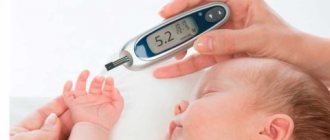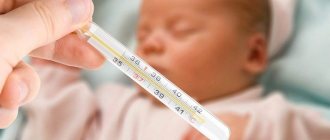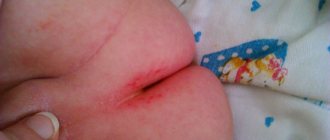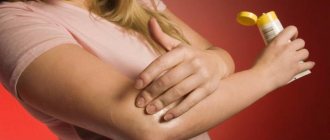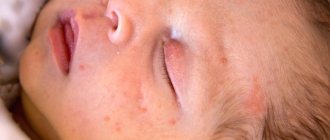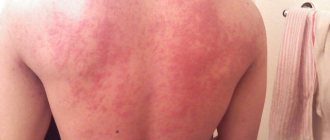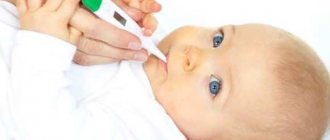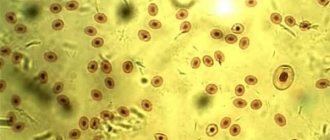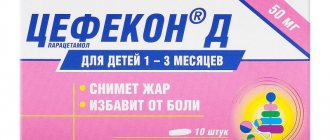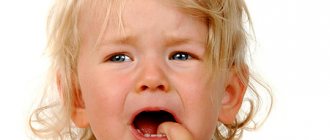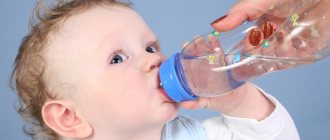Rashes on the legs of a child occur at different ages. Their formation can indicate serious problems in the body, and is also often a minor consequence of violations of the rules of care or insect bites. Only a competent clarification of the cause of the rash on the child’s legs will help to cope with the situation.
The nature of rashes on children's legs is different
Types of rash on the legs and its location
Often the site where the rash appears indicates the original cause of its appearance. For example, the location of an allergic rash indicates the location of contact with the irritant.
There are many types of rashes:
- small red or pink rash;
- large red pimples;
- transparent colorless blisters;
- single or grouped pimples;
- rough dry rashes.
As the disease develops, the sores may change and spread to other areas.
Factors in the formation of a rash on the inner thighs
There are many reasons why spots or blisters appear on the skin of the legs. If they are physiological in nature, then they do not pose any threat to health. If the rash on the inside of the thigh is a symptom of the disease, then it needs to be treated immediately.
Natural
Rashes on the inner thigh are formed due to the following physiological phenomena:
- Failure to comply with personal hygiene rules.
- Wearing tight, poor quality and poorly ventilated clothing.
- Poor nutrition leading to vitamin deficiency in the body.
- Excessive oily skin.
- Insect bites.
These factors do not pose a health hazard. To prevent rashes from appearing, it is enough to exclude these provoking factors from a person’s life or try to avoid them as much as possible.
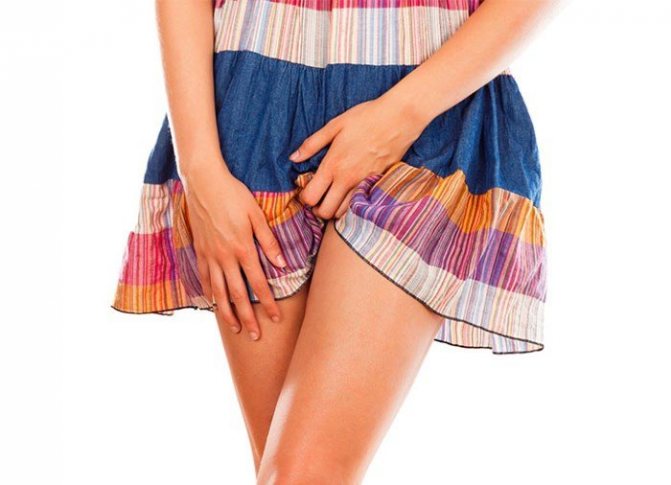
Pathological
Diseases that can cause a rash on the thighs include:
- Mycosis. It is a fungal infection of the integument. There are favorable conditions for the growth of fungus in the posterior femoral region, since this place is warm and humid. Usually the disease affects people who play sports: they actively sweat.
- Genital herpes. Pathology is transmitted sexually. More often, pimples form directly on the genitals, but can go down below.
- Contact dermatitis. Most often, it is this phenomenon that leads to the formation of spots on the skin of the thighs. The pathological process develops as a result of contact with an irritant. In mild cases, the rash disappears on its own; in severe forms, treatment is required.
- Psoriasis. It appears in the form of spots that do not cause discomfort to the patient, but as they grow, they begin to peel off greatly.
Skin pathologies require medical intervention, otherwise they can cover more and more areas of the epidermis.
Causes
Blue lips in a child under one year old - possible causes
A rash on a child's legs can be caused by various reasons. All of them can be divided into several large groups:
- blood and vascular diseases;
- diseases caused by infections or parasites;
- allergy;
- non-compliance with the rules of care and proper nutrition.
On a note. Whatever disease causes the sores, it should first be identified. It is more correct to do this together with a doctor, who will subsequently prescribe treatment.
Diseases of the blood and blood vessels
Sometimes rashes on the legs are associated with diseases of the blood and blood vessels. Externally, such a rash on a child’s thighs (on the inside or outside) differs from an allergic or infectious one. Most often in such situations, hemorrhagic rashes occur, which, in fact, are not sores, but hemorrhages. Outwardly, they look more like red dots, bruises or hematomas.
In some cases, they merge into solid spots. In addition to the rash, there are additional symptoms:
- joint pain;
- fever and chills;
- weakness;
- nausea;
- headache.
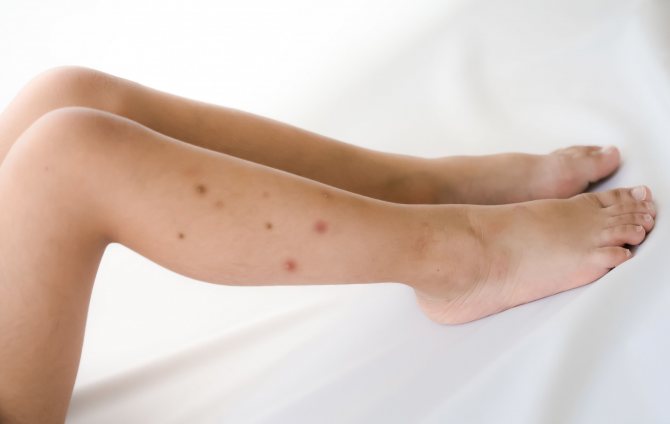
Hemorrhagic rashes look more like bruises
Among the common diseases of the blood and blood vessels are:
- hemorrhagic vasculitis (affected area - legs and feet);
- thrombocytopenic purpula (diagnosed when the level of platelets in the blood drops).
The appearance of rashes in the form of ulcers on the soles indicates an advanced stage of diseases of the circulatory system.
Allergic reaction
The formation of an allergic rash on the legs, arms, feet and heels may be due to an irritant. Spots appear on the body, which are accompanied by itching. In infants, the rash most often appears under the knees. A child may develop a rash on one leg, but not on the other.
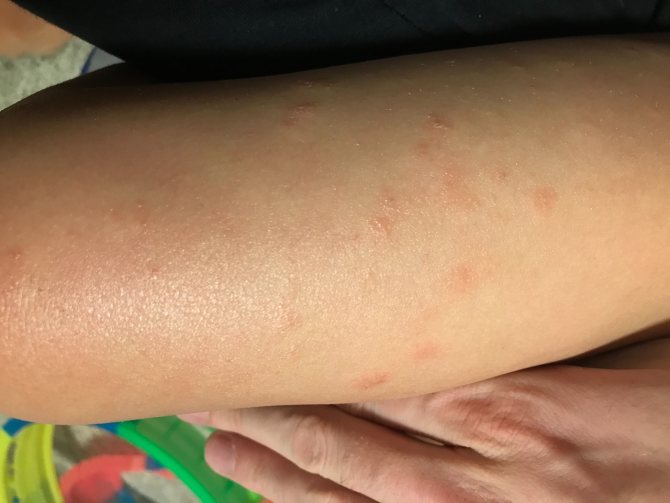
Allergy rashes differ in the location and nature of the sores
The most common allergens are:
- food products (cow's milk, citrus fruits);
- dust;
- medicines;
- ultraviolet;
- dust;
- animal hair;
- low-quality synthetic clothing.
On a note. If allergens get inside the body, they can provoke tissue swelling and the appearance of tumors without other visible reasons.
Initially, allergies appear as red and pink spots that itch, especially when night falls. They can crust over, peel off, and rot.
Infectious diseases
In addition to the rash on the child’s body (its localization varies), other signs of deterioration in the baby’s health appear.
Common symptoms of infectious diseases include:
- elevated temperature;
- chills;
- cough;
- nausea or vomiting;
- pain in the stomach, throat.
Depending on the type of infection, the first symptoms appear immediately after the rash or after a few days. If, in addition to the legs, the rash appears on other parts of the body, then there may be infection with scarlet fever, chickenpox, rubella, tonsillitis or measles.
On a note. The most dangerous infection is meningococcus. The disease is easily treatable, but if left untreated it quickly leads to meningitis.
Peeling and rashes on a child’s feet can be caused by a fungus.
Poor hygiene
Skin irritation and rashes are often provoked by simple lack of personal hygiene (the problem often occurs in children under one year old). In this case, the baby develops a rash on the thighs or other parts of the body.
One of the problems caused by poor hygiene is heat rash. Small blisters and pimples appear on the body. Their formation, in addition to poor quality care, is provoked by too high a temperature in the room or excessive wrapping of the child.
Allergic contact dermatitis
In allergic contact dermatitis, the rash is characterized by additional swelling. The sores look like reddish blisters filled with liquid. A one-year-old child constantly has the desire to scratch the affected area.
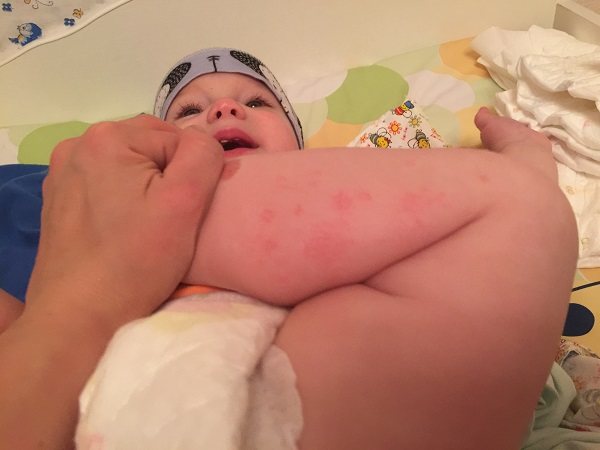
Allergic contact dermatitis first appears at the site of contact with the irritant
On a note. If the bubble bursts, erosion may form in its place. After the pain subsides, yellow crusts appear.
Hormonal imbalance and vitamin deficiency
Infants may experience hormonal imbalances due to adaptation to the outside world. They are associated with any changes in the endocrine system. A symptom of this problem is a rash on the child’s feet or other parts of the body.
Lack of vitamins affects the skin. In addition to exacerbation of existing skin problems, hair loss, dryness and flaking of the skin are observed.
How does it manifest?
Skin rashes can look different. It depends on the reason that caused their appearance.
New rashes have a more intense color. Skin elements that have appeared on the skin for quite some time, as a rule, become less noticeable. Some rashes are accompanied by severe skin itching, which can bother the baby both during the day and at night.
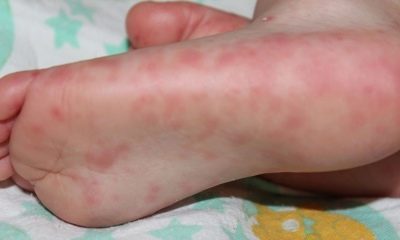
Allergy
Allergic rashes on the palms and feet look like bright red spots. These skin formations can vary in size. They usually reach a length of 2-8 mm. A severe allergic reaction is accompanied by the appearance of a large number of different rashes.
Severe itching of the skin causes the sick baby to begin scratching the damaged areas of the skin. This can lead to secondary bacterial infection entering the resulting wounds, which causes infection and suppuration.
Chickenpox
Chicken pox is manifested by the appearance of various blisters on the baby's skin. There is a yellowish liquid inside them. These bubbles can burst with the contents leaking out. In place of such damaged areas, ulcers form, which gradually heal over time. It takes 7-10 days for complete recovery from the rash.
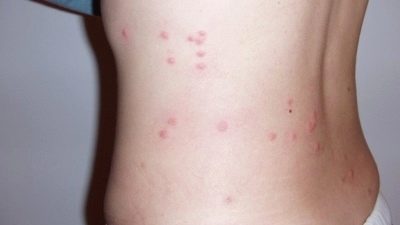
Scabies
With scabies, numerous red spots appear on the skin. They usually resemble a small rash. These rashes are very itchy. These skin manifestations form at the entry and exit points of scabies mites. Scabies is a contagious disease and spreads from a sick person to a healthy one.
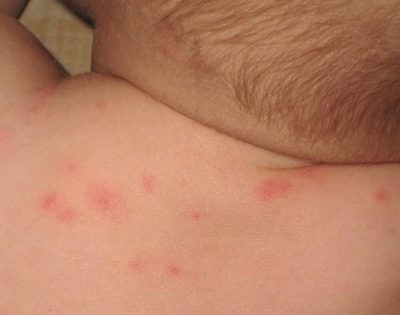
Dyshidrosis
In some cases, the baby develops multiple blisters located on the palms of the hands. These rashes are a manifestation of dyshidrosis. This pathological condition occurs with increased sweating and disruption of the sebaceous and sweat glands. This disease manifests itself by the development of multiple rashes, inside of which there is a watery liquid.
READ ALSO: How to remove blackheads on the face at home in 1 day
This pathology is more common in the hot season . In infants, dyshidrosis is somewhat more common. This feature is due to the fact that thermoregulation in children of this age still does not work effectively enough.
Excessive sweating on a child’s feet can also lead to active growth of fungal flora. In this case, the course of the disease worsens significantly.
In the initial stage of dyshidrosis, red areas appear on the skin of the palms or feet, which are manifested by a strong tingling sensation. Only after a few days do rashes appear on the skin. At this stage, the itching and burning of damaged skin also increases significantly. The bubbles range in size from 2 to 10 mm.
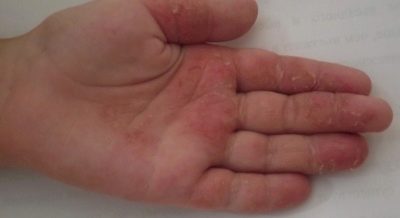
The duration of rashes with dyshidrosis may vary. Typically, skin manifestations bother the baby for 10-14 days. Then, with proper local treatment, they completely disappear. Similar rashes in the baby may occur again if his general condition is disturbed. Decreased immunity and severe overheating only contribute to the progression of this condition in the child.
Diagnostic methods
Frequent urination in a child under one year old - possible causes
Only a doctor can accurately diagnose the rash. When identifying the cause of rash formation, various diagnostic methods are used:
- interviewing the child’s parents and taking a detailed medical history;
- scraping of skin particles for laboratory testing;
- palpation of spots;
- visual inspection;
- examination of rashes under a microscope;
- general blood, urine and stool tests.
On a note. Depending on the results of all procedures performed, the doctor will make a diagnosis.
Tips for parents
If a rash appears on a child’s legs, there is no need to panic or do rash things, just consult a doctor. In order not to blur the clinical picture, there is no need to use coloring preparations for itching.
What can cause ear pain in a child under one year old?
Do not use alcohol-containing compounds - they can cause burns. It is also important to review all of your baby’s clothes and remove synthetic items.
Important! Before visiting a doctor, exclude any self-medication.
Which doctor should I contact?
A small child is initially shown to a pediatrician. The children's doctor will conduct a series of examinations, with the help of which he will establish a preliminary diagnosis and provide explanations for care.
If necessary, the pediatrician will refer you to a specialized specialist. This could be a dermatologist, allergist, hematologist, endocrinologist or neurologist.
When to sound the alarm
It is ideal to immediately show the child to the pediatrician when a rash appears. If necessary, he will redirect to a related specialist (hematologist, dermatologist, endocrinologist).
If the appearance of rashes has a number of additional symptoms, then you should definitely call an ambulance:
- painful itching;
- heat;
- painful sensations;
- swelling;
- suppuration;
- rapid spread throughout the body;
- additional symptoms of respiratory diseases.
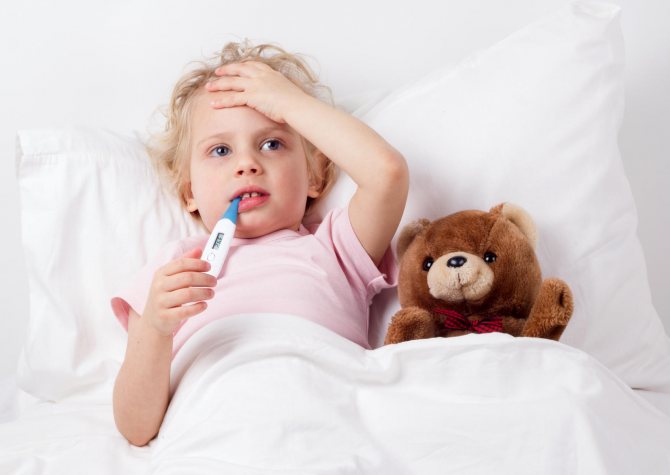
High temperature is a signal to call a doctor
Some diseases progress quickly, which can cause significant harm to the baby’s health if left untreated.
What can you do at home?
Only known diseases can be treated at home. If parents have already encountered allergies, prickly heat or dermatitis, they know the sequence of actions.
In case of allergies, it is important to initially exclude contact with the irritant and provide the skin with proper care. If any doubt arises, seek medical help as soon as possible.
Correct treatment
The first step to treating any rash on your child's feet is to determine the cause. This requires a medical examination, which is best done immediately. But, without knowing the cause, or noticing the progressive nature of the disease, it is recommended to follow a few simple rules, which may determine the difficulty of dealing with a rash on the legs. They consist of three simple recommendations, the implementation of which will not be difficult:
- Call a dermatologist at home. The appearance of pimples on a child's skin can be caused by a contagious infectious disease. Rubella is considered especially dangerous due to its high virulence and contagiousness. It is dangerous for a sick child, but not as much as for expectant mothers - the disease affects the fetus during pregnancy. In addition, a simple trip with a sick child on public transport can cause a local epidemic of rubella.
- An immediate call to the doctor is mandatory when parents suspect meningococcal infection. It is considered one of the most serious childhood infectious diseases and requires urgent hospitalization of the child.
You should not try to fight the rash with “folk” remedies like iodine or brilliant green. The reason for its appearance lies inside the body and pimples are a symptom, not the disease itself. Until the problem itself is solved, in this case the cause of the rash, its consequences cannot be eliminated. Traditional methods of treatment can only complicate the process of making a diagnosis for a dermatologist due to the inability to identify manifestations by the appearance of the rash.
Possible complications
Any skin rashes do not appear on the legs and arms without a specific reason. It is the nature of the sores that poses a danger to the baby. Allergies are dangerous for newborn children because, if left untreated, they can progress and become chronic diseases.
On a note. Any pathology of an infectious nature has its own complications, which lead to serious health problems. Subsequently, the child may suffer from them throughout his life.
The main causes of rash on the legs in children under 1 year of age
Rash in infants is of particular concern to parents. Babies may become fussy and have difficulty sleeping and eating. They are unable to explain what is bothering them. The most common causes of rashes on the legs and bottom in children under one year of age are allergic reactions due to the introduction of new foods into the diet and diaper dermatitis:
- If their appearance was preceded by the nursing mother consuming a new product, then the formations on the skin are a consequence of the baby’s reaction to this food. It is necessary to introduce complementary foods to babies with caution. Some foods can cause a skin reaction even days after eating them.
- Allergic reactions in infants can also be caused by household chemicals (for example, washing powder, cream) and pet hair. They are expressed by redness and pimples on the butt and thighs (we recommend reading: how to treat acne on the butt in a 5-year-old child?).
- The use of medications is another cause of allergies. Redness appears on the body a short time after the medicine penetrates the baby’s body.
- Diaper dermatitis in newborns is caused by improper child hygiene or overheating (for more details, see the article: diaper dermatitis: symptoms with photos). The rashes merge into a large red spot in the area of the buttocks and thighs. To eliminate the reaction, it is enough to take air baths and bathe the baby in herbal decoctions.
- Dermatitis in the form of scaly and red patches may be atopic in nature. Its treatment involves the use of herbal baths and medications.
READ ALSO: Lichen vesica: causes, symptoms, diagnosis, treatment methods
Atopic dermatitis on the feet of a baby
- Small pimples with watery contents in the folds of the legs are signs of heat rash in a baby. This rash is caused by high temperature conditions, high humidity, lack of hygiene, and the presence of warm clothing on the baby’s body. Eliminating the cause of the disease allows you to get rid of prickly heat. You can make your child feel better with the help of powders and creams.
- During the first months of life, most newborn babies develop small white pimples called milia on their bodies. They are natural in nature, as they are caused by the physiological imperfection of the sebaceous ducts of the newborn. The fatty spots usually go away after two to three months; you cannot remove them yourself.
- Melanosis in the form of white spots on the body is a very rare occurrence for newborn babies. It usually goes away within three weeks after it occurs.
Sometimes the causes of rashes in children aged 0 to 1 year are infectious. The appearance of the following symptoms may indicate to parents that there are serious problems in the baby’s body:
- acne spreads throughout the body;
- there is an increase in temperature;
- there is an increase in lymph nodes;
- the baby becomes lethargic;
- There may be vomiting and diarrhea.
Infectious rash all over the baby's body
Preventive actions
In order not to treat rashes on the legs and arms of young children, it is recommended to follow certain rules and recommendations of pediatricians. Simple preventive measures can help you avoid such problems at all:
- strengthening the immune system;
- the child should always be dressed appropriately for the weather;
- careful observance of personal hygiene from the first months of life;
- regular visits to the pediatrician, completion of prescribed vaccinations;
- use of hypoallergenic washing powders and cosmetics;
- children's things must be made of high-quality materials;
- proper balanced nutrition.
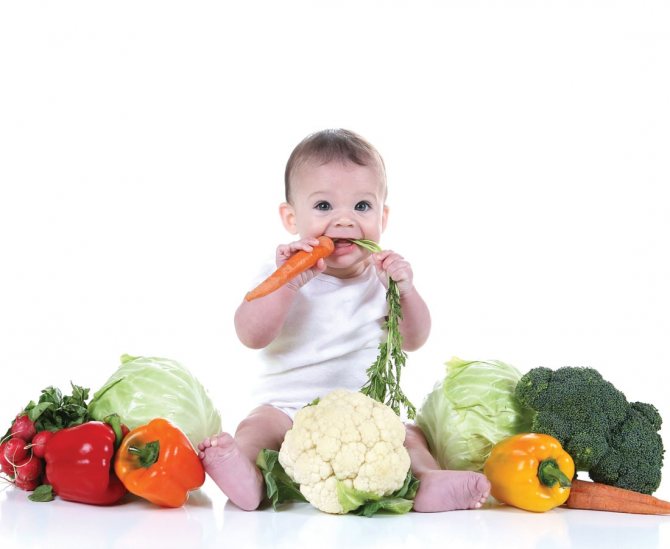
It is important to teach your child personal hygiene and proper nutrition.
Any rash on the baby’s limbs brings him a number of unpleasant sensations: aesthetic inconvenience, itching, discomfort. They mean there are health problems. Parents begin to get nervous without finding out the cause and decide to self-medicate, which can lead to even bigger problems. Without the doctor’s permission, you cannot even use traditional medicine recipes, which may not help but result in complications.
Main locations
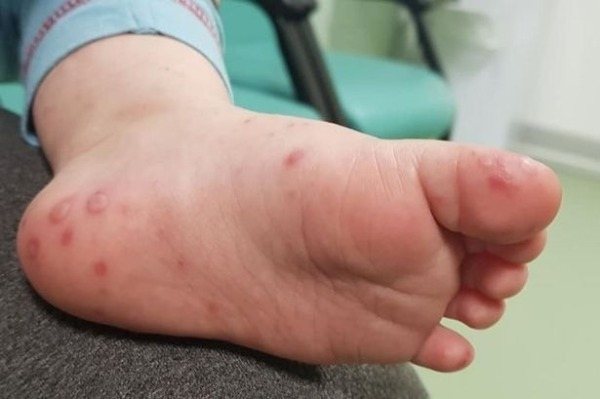
When making a preliminary diagnosis, not only the nature, but the location of the pustular elements is important:
- Red spots and blisters on the wrists and palms are typical when the body is affected by bacterial infections.
- Pustular elements between the fingers are caused by scabies and mite bites.
- Fungal diseases affect the phalanges of the fingers and toes.
- Spots and pustules on the bends of the limbs may indicate dermatological pathologies of a non-infectious nature.
- Papular elements on the thighs and legs can develop as a result of meningococcemia and pathologies of the circulatory system.
If hygiene and allergies are not observed, pathological manifestations are observed throughout the body.
Be sure to read:
Acne on the chin in women: causes and solutions
